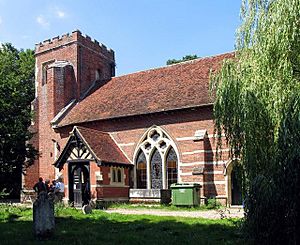St Michael's Church, Berechurch facts for kids
Quick facts for kids St Michael's Church, Berechurch |
|
|---|---|

St Michael's Church, Berechurch, from the southeast
|
|
| Lua error in Module:Location_map at line 420: attempt to index field 'wikibase' (a nil value). | |
| OS grid reference | TL 993 219 |
| Location | Berechurch, Essex |
| Country | England |
| Denomination | Anglican |
| Website | Churches Conservation Trust |
| History | |
| Dedication | Saint Michael |
| Architecture | |
| Functional status | Redundant |
| Heritage designation | Grade II* |
| Designated | 24 February 1950 |
| Architect(s) | Charles Pertwee (partial rebuilding) |
| Architectural type | Church |
| Style | Gothic, Gothic Revival |
| Completed | 1878 |
| Closed | 1975 |
| Specifications | |
| Materials | Brick with stone banding and dressings Roof tiled |
St Michael's Church is an old Anglican church in the village of Berechurch, Essex, England. It's no longer used for regular church services, but it's a very important historical building. It's protected as a Grade II* listed building, which means it's special and needs to be looked after. The Churches Conservation Trust takes care of it. You can find the church south of Colchester, on Berechurch Hall Road.
Contents
History of St Michael's Church
Early Beginnings and Changes
St Michael's was never a main parish church. Instead, it was a "chapel of ease." This means it was a smaller church built to help people who lived far from the main Holy Trinity Church in Colchester. It's possible there was a church here as early as the 11th century. The oldest part of the building we see today is the tower, which was built in the 14th century.
Most of the church was rebuilt in the late 15th century. Workers used some of the older stones and materials again. In the early 16th century, a special chapel was added to the north side of the church. This chapel was finished before 1533.
The Audley Chapel and Later Work
In 1536, a very important person named Thomas Audley got permission to make Berechurch a separate church area. Thomas Audley was the Lord Chancellor for King Henry VIII. Many people believe he was the one who built the new chapel. Today, this chapel is named the Audley Chapel after him. More building work was done on the church in the early 17th century.
Rebuilding and New Churches
In 1872, most of the church was rebuilt again by an architect named Charles Pertwee. Only the old tower and the Audley Chapel were kept from the earlier church. The south porch, which is like a covered entrance, was added in 1878.
After World War II, the town of Colchester grew a lot. Many new homes were built nearby. St Michael's Church became too small for all the people who wanted to attend services. So, a new church, called Saint Margaret's, was built close by between 1968 and 1972. The church community moved to the new building in 1973. St Michael's was then declared "redundant" in 1975. This means it was no longer needed for regular church services. The main part of the church was changed for other uses, but the Audley Chapel was given to the Churches Conservation Trust in 1981 to be preserved.
Architecture of the Church
Outside the Church
St Michael's Church is built with bricks and has stone decorations. The roofs are made of tiles. You can see pretty stone patterns around the main part of the church and the chapel. The church has a main hall called a nave, a special area near the altar called a chancel, and the Audley Chapel on the north side. There's also a south porch and a tall tower on the west side.
The tower has three levels. It has strong supports called buttresses at the corners and a small stair turret on the southeast side. The top of the tower has a battlemented parapet, which looks like the top of a castle wall. There's a door and a window on the west side of the tower. Bell openings are at the top of the tower on all sides.
The windows in the nave were all added in the 19th century. The large window to the east of the porch is especially big. The east window of the chancel was moved from the older church. It's from the early 17th century and has Perpendicular-style tracery, which means it has decorative stone patterns. The Audley Chapel has a big window with three sections from the 16th century, also with brick tracery. The west wall of the chapel has a brick doorway from the 16th century.
Inside the Church
The nave, chancel, and tower areas have been changed and are now used for things other than church services.
The Audley Chapel has a special type of roof called a hammerbeam roof. It has carvings that include symbols of King Henry VIII and Catherine of Aragon. You can also see heraldic badges on the roof, which show the family symbols of the Audley family.
The chapel also has monuments to important people. The most famous one is for Sir Henry Audley. It was put up in 1648, even before he passed away. This monument shows a white marble statue of him lying down in his armor. It sits on a black and white chest that has carved figures of his five children. There's also a stone tablet for Robert Audley, who passed away in 1624. It has memento mori designs, which are symbols that remind people about death. There are more memorials from the 19th century as well.
Churchyard Features
The churchyard is the area around the church. It contains the war graves of two officers who served in World War I. One was from the army and the other from the Royal Air Force.
See also

